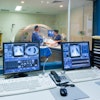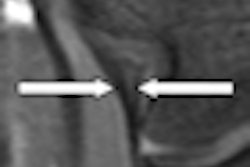
A controversial European Union law that potentially could threaten the use of MRI in research laboratories and medical clinics will be overhauled, clearing the way for the technology to continue being used across Europe, according to an accord announced last week by EU officials.
Speaking at a September 29 reception at the European Parliament in Brussels, László Andor, EU commissioner for employment, social affairs, and inclusion, said the European Commission would formally propose a revision to the 2004 EU directive limiting workers' exposure to electromagnetic fields (EMF) before the end of the year, known informally as the EMF Directive. The revision will effectively exclude MRI scanners from the scope of the directive by removing exposure restrictions on the technology.
"We are very close to proposing a win-win solution," Andor told the reception, organized by the Alliance for MRI advocacy group. "No binding exposure limits will be imposed on MRI."
Andor said the move came after long discussions between the European Commission and the Alliance for MRI, as well as research into the potential dangers of radiation exposure from the scanners. The Alliance for MRI argued that MRI had been in use for more than 25 years, imaging up to 500 million patients without evidence of harm to workers due to EMF exposure.
Although MRI magnets can affect metal objects, the Alliance for MRI said the scanners are free from most health risks associated with ionizing radiation such as x-rays. Andor said the European Commission eventually reached the same conclusion. "New scientific studies have not indicated any harmful effects from MRIs," he said.
However, the revision would be accompanied by new qualitative measures for healthcare workers, covering procedures governing access to examination rooms, training tools, and the dissemination of best practices, Andor said.
Hearty applause
The announcement was heartily applauded at the reception, which included radiologists, representatives of key medical federations, patient representatives, and EU officials. One of the advocates for reform, Frank Boeye, set up the Belgium-based Werkgroep Hersentumoren after an MRI scan found a tumor on his brain -- whereas a CT scan a week earlier had missed it. "I owe my life to MRI," he said.
European Society of Radiology (ESR) vice president Gabriel Krestin, MD, PhD, pointed out that he was a worker -- and, thus, supposedly protected by the directive -- but he had spent hundreds of hours working next to MRI scanners. He emphasized the value of MRI as an essential tool in fighting against life-threatening diseases such as brain tumors, cancers, and heart conditions.
 |
| From left to right: Gabriel Krestin, MD, PhD, ESR vice president; László Andor, EU employment, social affairs, and inclusion commissioner; Liz Lynne, British Liberal Democrat MEP; Alejandro Cercas, Spanish Socialist MEP. |
The Alliance for MRI's biggest champion in the European Parliament, British Liberal Democrat Member of the European Parliament (MEP) Liz Lynne, pledged to help usher the measure through the institution so that it would be formally approved by the EU by June next year.
Lynne is the vice chair of the Parliament's crucial Committee on Employment and Social Affairs, which will eventually scrutinize the revised directive. She hopes to draft the Parliament's opinion on the revision: Lynne had been a rare vocal opponent of the 2004 directive before it was adopted, but she was ignored at the time.
"People thought I was dramatizing," she said. Lynne had originally wanted MRIs excluded from the directive, but she accepted the solution of removing limit values. "This is the next best thing," she said. "It's a very positive outcome."
Spanish Socialist MEP Alejandro Cercas, who also sits in the Parliament's Committee on Employment and Social Affairs, was also at the reception and indicated that he might be able to swing the powerful left-of-center Socialist and Democrat (S&D) group behind the revision. "It is a very important piece of legislation, but it can be improved," he said.
The Physical Agents (Electromagnetic Field) 2004/40/EC directive was formally approved by the EU in 2004, with a four-year deadline for implementation. It was originally designed to address health risks for those working in the electrical power and telecommunication industries.
However, the EMF Directive quickly came under fire for its potential unintended consequences, and in April 2008, just one week before it was due to be come into effect, the implementation deadline was set back a further four years to April 2012.
Some insiders blamed the entire affair on a bureaucratic bungle: The directive was initially created as a worker safety measure and overseen by the European Commission's Directorate General for Employment, Social Affairs, and Equal Opportunities; the Commission's Directorate General for Health and Consumers was sidelined during the entire legislative process.
Speaking to AuntMinnie.com afterward, Andor suggested that officials had been overhasty and overzealous when they first drafted the law.
"This was not sufficiently thought through," he said. "Sometime, mistakes can be made from good intentions, when you try to make it bulletproof."
By Leo Cendrowicz
AuntMinnie.com contributing writer
October 5, 2010
Related Reading
European Parliament finalizes delay of EMF directive, February 21, 2008
European Commission delays MRI usage directive, October 29, 2007
Alliance for MRI gains delay, but new European rules still loom, July 26, 2007
Scientists warn new E.U. rules threaten MRI scans, June 11, 2007
European radiology mobilizes to stave off MRI safety rules, March 9, 2007
Copyright © 2010 AuntMinnie.com



.fFmgij6Hin.png?auto=compress%2Cformat&fit=crop&h=100&q=70&w=100)




.fFmgij6Hin.png?auto=compress%2Cformat&fit=crop&h=167&q=70&w=250)











